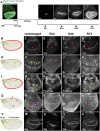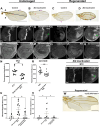This is a preprint.
The pioneer transcription factor Zelda facilitates the exit from regeneration and restoration of patterning in Drosophila
- PMID: 38854062
- PMCID: PMC11160785
- DOI: 10.1101/2024.05.30.596672
The pioneer transcription factor Zelda facilitates the exit from regeneration and restoration of patterning in Drosophila
Update in
-
The pioneer transcription factor Zelda controls the exit from regeneration and restoration of patterning in Drosophila.Sci Adv. 2025 Jun 6;11(23):eads5743. doi: 10.1126/sciadv.ads5743. Epub 2025 Jun 6. Sci Adv. 2025. PMID: 40479065 Free PMC article.
Abstract
For a damaged tissue to regenerate, the injured site must repair the wound, proliferate, and restore the correct patterning and cell types. We found that Zelda, a pioneer transcription factor largely known for its role in embryonic zygotic genome activation, is dispensable for normal wing development but crucial for wing disc patterning during regeneration. Impairing Zelda function during disc regeneration resulted in adult wings with a plethora of cell fate errors, affecting the veins, margins, and posterior compartment identity. Using CUT&RUN, we identified and validated targets of Zelda including the cell fate genes cut, Delta and achaete, which failed to return to their normal expression patterns upon loss of Zelda. In addition, Zelda controls expression of factors previously established to preserve cell fate during regeneration like taranis and osa, which stabilizes engrailed expression during regeneration, thereby preserving posterior identity. Finally, Zelda ensures proper expression of the integrins encoded by multiple edematous wings and myospheroid during regeneration to prevent blisters in the resuting adult wing. Thus, Zelda is crucial for maintaining cell fate and structural architecture of the regenerating tissue.
Conflict of interest statement
Declaration of interests The authors declare no competing interests. K.S.’s current institutional affiliation is the Center for Developmental Genetics, New York University. S.S.’s current institutional affiliation is the Roy J. Carver Biotechnology Center, University of Illinois at Urbana-Champaign.
Figures







Similar articles
-
The pioneer transcription factor Zelda controls the exit from regeneration and restoration of patterning in Drosophila.Sci Adv. 2025 Jun 6;11(23):eads5743. doi: 10.1126/sciadv.ads5743. Epub 2025 Jun 6. Sci Adv. 2025. PMID: 40479065 Free PMC article.
-
Taranis Protects Regenerating Tissue from Fate Changes Induced by the Wound Response in Drosophila.Dev Cell. 2015 Jul 6;34(1):119-28. doi: 10.1016/j.devcel.2015.04.017. Epub 2015 Jun 18. Dev Cell. 2015. PMID: 26096735
-
GAF is essential for zygotic genome activation and chromatin accessibility in the early Drosophila embryo.Elife. 2021 Mar 15;10:e66668. doi: 10.7554/eLife.66668. Elife. 2021. PMID: 33720012 Free PMC article.
-
The embryonic transcription factor Zelda of Drosophila melanogaster is also expressed in larvae and may regulate developmentally important genes.Biochem Biophys Res Commun. 2013 Aug 23;438(2):329-33. doi: 10.1016/j.bbrc.2013.07.071. Epub 2013 Jul 24. Biochem Biophys Res Commun. 2013. PMID: 23891688
-
Growth and patterning from the engrailed interface.Int J Dev Biol. 1998;42(3):317-24. Int J Dev Biol. 1998. PMID: 9654015 Review.
References
Publication types
Grants and funding
LinkOut - more resources
Full Text Sources
Molecular Biology Databases
